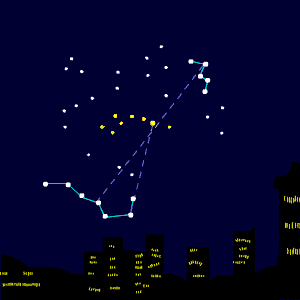Not an expert at this by any means, but have spent the last 6 years doing astronomy-related science-communication, so will answer what I can - first up, nice animation

In rough order then...
@petrochemicals - oftentimes, the brightest object will stand out while moving about, even just letting your eyes de-focus can work. This doesn't help with the Pole Star/North Star/Polaris though, as it's not that bright (as widu13 pointed out). It would be good for finding Sirius in the winter in the UK though (seasonal visibility will vary depending on where you are as has been pointed out) or if you can see Orion, follow the line of his belt left, and it'll bring you to Sirius.
re Betelgeuse and brightness, unless you plan on doing some interstellar travel, the apparent magnitude is what you need to look at, ie how bright an object appears to be when viewed from Earth. In this case from the UK for stars, that would be Sirius if it's visible, though Betelgeuse is much brighter in absolute magnitude, it's 53.some times further away from us, so appears dimmer. Teeny background bit on magnitude, it works 'backwards' ie the lower the value the brighter the object (Betelgeuse 0.45 and Sirius -1.45 [yep, that's not typo, negative magnitude values for the brightest things up there, like Venus, or the International Space Station, or Iridium Flares {reflected light from Iridium comm satellites which can be as bright as -8! Easy to find too, shout if you're interested}]).
Apps like Skymap, Google Sky, SkEye or whatever are great for getting info and such, but you can't beat getting familiar with the real night sky, and it doesn't need batteries

Fun fact - once Orion is visible in the UK skies again later in the year, when you look at Betelgeuse, you're looking at Betelgeuse 427.some years ago, when the light left the star - flip that round, any life with big enough telescopes on a planet going round Betelgeuse right now, looking at Earth, would be seeing the planet as it was 427-odd years ago...





